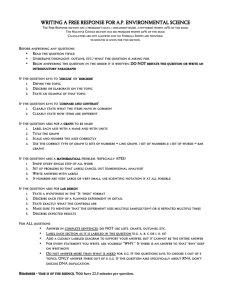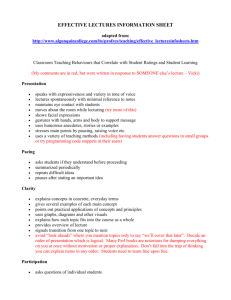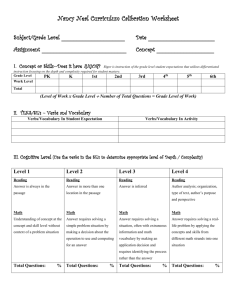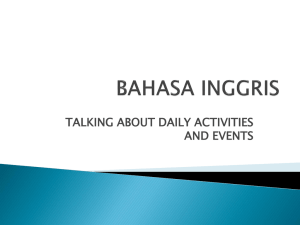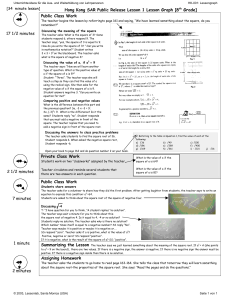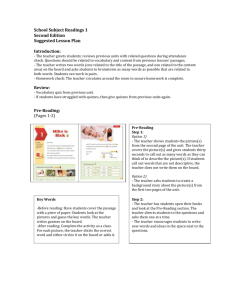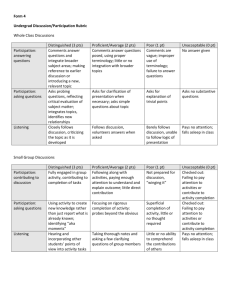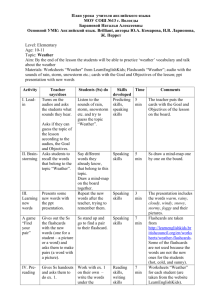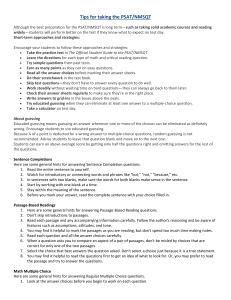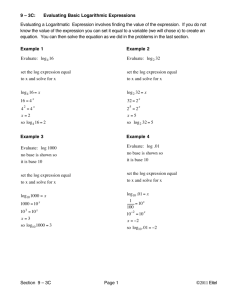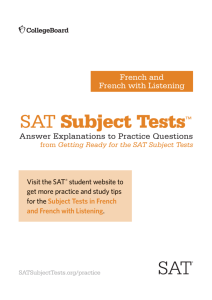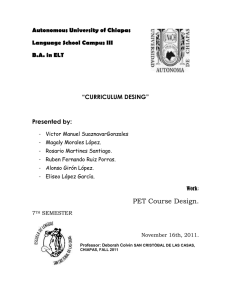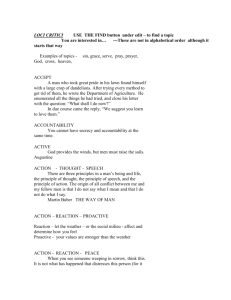Preparation Hints for the Free Response Questions on the AP
advertisement
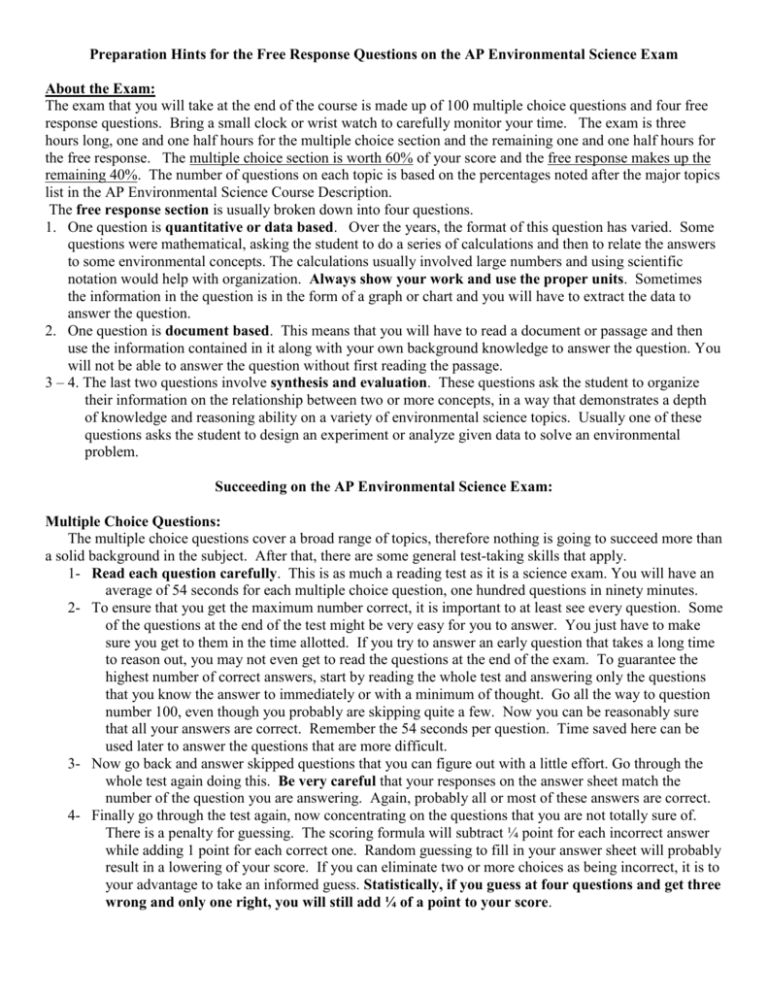
Preparation Hints for the Free Response Questions on the AP Environmental Science Exam About the Exam: The exam that you will take at the end of the course is made up of 100 multiple choice questions and four free response questions. Bring a small clock or wrist watch to carefully monitor your time. The exam is three hours long, one and one half hours for the multiple choice section and the remaining one and one half hours for the free response. The multiple choice section is worth 60% of your score and the free response makes up the remaining 40%. The number of questions on each topic is based on the percentages noted after the major topics list in the AP Environmental Science Course Description. The free response section is usually broken down into four questions. 1. One question is quantitative or data based. Over the years, the format of this question has varied. Some questions were mathematical, asking the student to do a series of calculations and then to relate the answers to some environmental concepts. The calculations usually involved large numbers and using scientific notation would help with organization. Always show your work and use the proper units. Sometimes the information in the question is in the form of a graph or chart and you will have to extract the data to answer the question. 2. One question is document based. This means that you will have to read a document or passage and then use the information contained in it along with your own background knowledge to answer the question. You will not be able to answer the question without first reading the passage. 3 – 4. The last two questions involve synthesis and evaluation. These questions ask the student to organize their information on the relationship between two or more concepts, in a way that demonstrates a depth of knowledge and reasoning ability on a variety of environmental science topics. Usually one of these questions asks the student to design an experiment or analyze given data to solve an environmental problem. Succeeding on the AP Environmental Science Exam: Multiple Choice Questions: The multiple choice questions cover a broad range of topics, therefore nothing is going to succeed more than a solid background in the subject. After that, there are some general test-taking skills that apply. 1- Read each question carefully. This is as much a reading test as it is a science exam. You will have an average of 54 seconds for each multiple choice question, one hundred questions in ninety minutes. 2- To ensure that you get the maximum number correct, it is important to at least see every question. Some of the questions at the end of the test might be very easy for you to answer. You just have to make sure you get to them in the time allotted. If you try to answer an early question that takes a long time to reason out, you may not even get to read the questions at the end of the exam. To guarantee the highest number of correct answers, start by reading the whole test and answering only the questions that you know the answer to immediately or with a minimum of thought. Go all the way to question number 100, even though you probably are skipping quite a few. Now you can be reasonably sure that all your answers are correct. Remember the 54 seconds per question. Time saved here can be used later to answer the questions that are more difficult. 3- Now go back and answer skipped questions that you can figure out with a little effort. Go through the whole test again doing this. Be very careful that your responses on the answer sheet match the number of the question you are answering. Again, probably all or most of these answers are correct. 4- Finally go through the test again, now concentrating on the questions that you are not totally sure of. There is a penalty for guessing. The scoring formula will subtract ¼ point for each incorrect answer while adding 1 point for each correct one. Random guessing to fill in your answer sheet will probably result in a lowering of your score. If you can eliminate two or more choices as being incorrect, it is to your advantage to take an informed guess. Statistically, if you guess at four questions and get three wrong and only one right, you will still add ¼ of a point to your score. Free Response Questions: There are four questions to be answered in ninety minutes, or about 22 minutes per question. It does not matter what order you answer the questions in. Start with the ones you know the most about. There is, for the most part, no penalty for guessing. The only time points are subtracted is when you answer a question by contradicting yourself. For example, saying something is true in one part and false in another. General Hints: 1- Write as neatly as you can, using a ball point pen with black ink. Do not use felt tipped pens. They bleed through the paper and make your answers hard to read. 2- If you make a mistake, just draw a line or two through the part you want omitted and continue. 3- You must answer each question in full sentences. Lists, outlines and bulleted items will not be scored, no matter how much correct information they contain. The same is true about charts and diagrams. Unless they are specifically asked for in the question, don’t waste your time with them in your answer booklet. 4- Spelling and good grammar are not graded, but remember the Reader must be able to tell what you are writing about. If you don’t know a particular term or how to spell it, describe it as best as you can. 5- Pay close attention to the verbs used in the questions. Compare, describe, evaluate, develop an argument each mean very specific tasks for you to do to answer the question. Each question is worth ten points. The scoring rubric has point values assigned to each part of the question. The scoring for a question starts at zero, and points are added for each good response up to a maximum of ten. The exam is designed to be very challenging. Don’t expect a ten on each question. A score of ten is very rare. The national average score on a free response question is usually between four and five. Obviously the more points you score the better. Remember, the exam is graded on a curve. You want to score as many points as possible, to be above the average. Each question is made up of multiple parts and many times covers different but related topics. Try every question. You will probably know something about each question, and therefore score points on each question. The free response questions require a lot more effort on your part. It is extremely important that you read each question carefully. As a Reader, I personally know of many students who knew the material asked in a question, but did not get any points because they did not answer the question the way it was asked. Specific Hints: 1- On the quantitative question, be as organized as you can be and show all your work. - Calculators are not allowed. Don’t write numbers all over the page. Be organized. It is easier for you to work and easier for the reader to follow your reasoning. Use scientific notation for all large numbers and values very much smaller than one. It will help you keep track of the decimal places. If you use a formula, write it out and show how you substituted values into it. Sometimes the question will involve the changing of units. Always label your values. Learn the factor-label method for converting units. If the question asks for a graph, there are some basics that must be followed. The independent variable is always the X (horizontal) axis and the dependent variable is always the Y (vertical) axis. Mark off the axes in proportional units, even if the data is not uniformly spaced. Label each axis and give the unit of measure. Plot the data points as accurately as you can and connect the points with a smooth continuous line, unless the instructions specifically tell you to do something different. If more than one line is plotted, label each one. Don’t use a legend on the side. Give the graph a title. 2- On the document-based question, be sure to carefully read the whole passage or document. The question will ask for specific information from the reading and then ask you to react to it 3- 4- using your knowledge of the topic. Be particularly alert to the verbs used in the question. They each mean different things. The verb compare will usually mean linking one item from the reading passage and one of your choosing in a specific way. Describe would be asking you to tell in some detail about an event or process outlined in the question. Develop an argument would mean that you will have to link together two or more pertinent facts about the topic asked. The synthesis and evaluation questions are a very sophisticated test of your reading ability and scientific background. The questions are knowledge based and require you to make connections between major topics in the course. Again it is extremely important that you read the question carefully. Make particular note of the verbs used. Don’t restate the question. This is not a formal debate or an English Composition class. Time is valuable. Write about what the question asks. Don’t waste time by giving long introductions or ecobabble on about historical perspectives. Get to the point and answer the question in a straight forward and complete way. If you are asked to give two examples, only your first two responses will be graded. Don’t give a longer list, hoping for the best. One word that students miss is economic. If the question asks for economic incentives, for example, it means a financial effect such as more money, tax breaks, less cost, etc. Review some of the previous year’s questions to see how this was missed by many students. Another term students seem to ignore, to their detriment is per capita. This means per person. Per capita energy use is the amount of energy used by the average person. Define and explain any terms you use. Don’t just name drop “buzz words”. Use examples wherever possible and be complete, but precise. Be sure to include the obvious in your explanations. Don’t assume the Readers will know what you mean. They won’t, unless you tell them. Be very complete, but to the point. Being thorough in your answer could score you extra points. If the question asks for a linking of concepts and you can’t think of any, tell what you know about each concept separately. Once more, use details wherever possible. Again, sometimes one of the questions asks you to design an experiment to solve an environmental problem. If this happens, there are a few things to keep in mind. Remember what is necessary for a good experiment. All experiments need a hypothesis. This should be a simple declarative sentence that can be tested. It is a prediction of what you think will happen. It is mandatory that it be included in your answer. You need to describe the variable that you will manipulate. Outline why you selected it and describe how you perform your tests. If this is going to be a controlled experiment, describe what variables you will control and how you will do it. If the experiment is a long term study, be sure that it runs for at least two or more cycles of the event you are studying. If your experiment involves organisms, be sure to describe their behavior as a result of the experiment. Tell what equipment you propose to use and why. Say how you will collect data and analyze it. If you draw a conclusion, be sure to connect your results to the hypothesis that you stated in the beginning. Lastly, your experimental design should be realistic and theoretically possible, based on accepted scientific theories and principles. Back to APES Home Page Back to APES Exam Review Page

